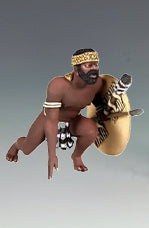CD022 - The Town Sheriff
As the wild and lawless 'cowtowns' of Kansas sprang up all along the main routes of the great cattle drives during the 1870s and 1880s law and order became an urgent necessity.
Helping to keep the peace as well as enforcing the law was often a lonely and dangerous occupation and demanded a special breed of lawmen who were as handy with their fists as they were with a six-gun.
In those days there were mainly two types of peace officer… One was a U.S. Marshal, normally appointed by a State or Territory's Attorney General.
The other, much more numerous, was the Sheriff, commonly elected by a county's residents or chosen by a local town council.
Many of these same Sheriffs received little or no pay but derived their income from a percentage of any money collected in fines or bounties raised on the heads of any 'wanted' criminals and desperados found in their jurisdictions.
In addition to this kind of uncertain income some Sheriffs also took a 'second job' or even held a financial interest in certain establishments frequented by the cowboys who drove the great herds passing through their towns. Saloons and bordellos being the most commercial… and profitable.
Our new Sheriff looks both well-dressed and well-armed with a fine shotgun in his hands and a Colt.45 'Peacemaker' on his hip.







